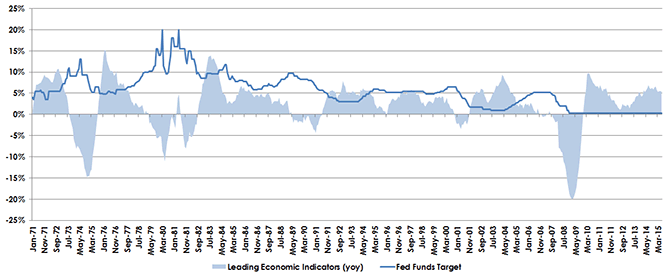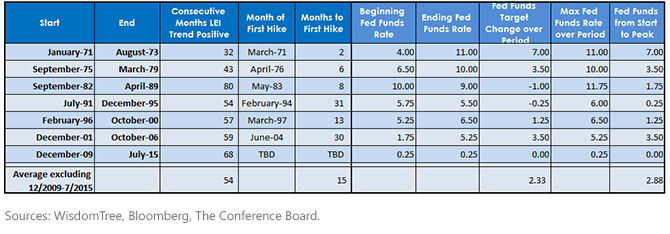Leading Economic Indicators Suggest It’s Time for the Fed to Hike


 Monetary Policy Changes in Regimes of Positive Trends in Leading Economic Indicators,
January 1971- July 2015
Monetary Policy Changes in Regimes of Positive Trends in Leading Economic Indicators,
January 1971- July 2015
 This recent streak, which started at the end of 2009, is now 68 months old, and still the Fed remains inactive—37 months longer than the second-longest period. The extraordinary monetary policy triggered by the financial crisis has in many ways overwhelmed economic fundamentals and altered incentives for participants in the capital markets. But followers of economic cycles continue to keep nuggets of information like this in their back pockets and wonder whether the Fed’s inactivity in recent years could come back to haunt us when cyclical forces return.
With the markets still relatively complacent about the upcoming Fed meeting, we could see rates adjust higher and additional volatility in the equity and commodity markets. The August employment reports could give the Federal Reserve the domestic cover to hike rates despite lingering global concerns. The trend in leading economic indicators would argue it’s about time.
This recent streak, which started at the end of 2009, is now 68 months old, and still the Fed remains inactive—37 months longer than the second-longest period. The extraordinary monetary policy triggered by the financial crisis has in many ways overwhelmed economic fundamentals and altered incentives for participants in the capital markets. But followers of economic cycles continue to keep nuggets of information like this in their back pockets and wonder whether the Fed’s inactivity in recent years could come back to haunt us when cyclical forces return.
With the markets still relatively complacent about the upcoming Fed meeting, we could see rates adjust higher and additional volatility in the equity and commodity markets. The August employment reports could give the Federal Reserve the domestic cover to hike rates despite lingering global concerns. The trend in leading economic indicators would argue it’s about time.

Rick Harper serves as the Chief Investment Officer, Fixed Income and Model Portfolios at WisdomTree Asset Management, where he oversees the firm’s suite of fixed income and currency exchange-traded funds. He is also a voting member of the WisdomTree Model Portfolio Investment Committee and takes a leading role in the management and oversight of the fixed income model allocations. He plays an active role in risk management and oversight within the firm.
Rick has over 29 years investment experience in strategy and portfolio management positions at prominent investment firms. Prior to joining WisdomTree in 2007, Rick held senior level strategist roles with RBC Dain Rauscher, Bank One Capital Markets, ETF Advisors, and Nuveen Investments. At ETF Advisors, he was the portfolio manager and developer of some of the first fixed income exchange-traded funds. His research has been featured in leading periodicals including the Journal of Portfolio Management and the Journal of Indexes. He graduated from Emory University and earned his MBA at Indiana University.

